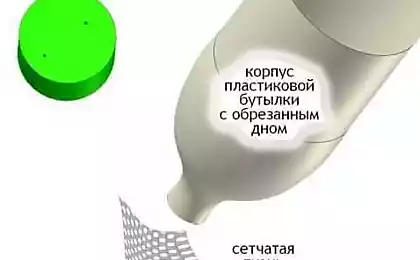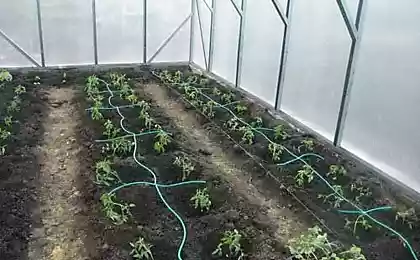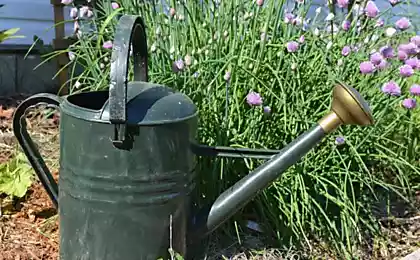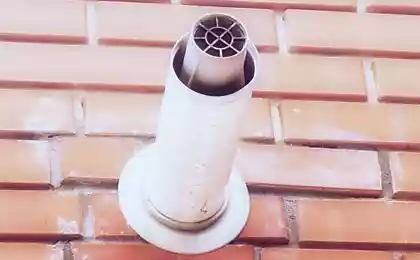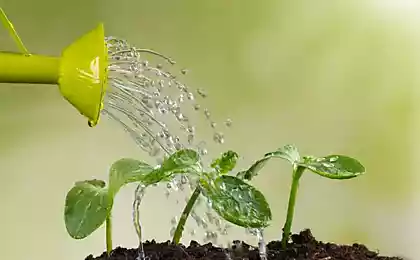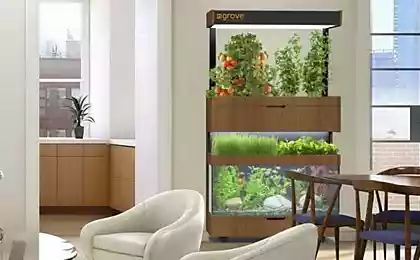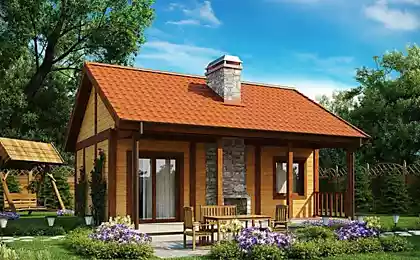552
Sprinkler and drip irrigation systems – advantages and features of installation
After a few years of self-watering with a hose every gardener comes to thinking about connecting to this goal of automation. Despite popular belief about the high cost of materials to lay out necessary highways and connect them to the controller with their hands. There are drip and sprinkler irrigation systems, which are designed for different purposes, but the result is the same – will have more free time for leisure and other things.
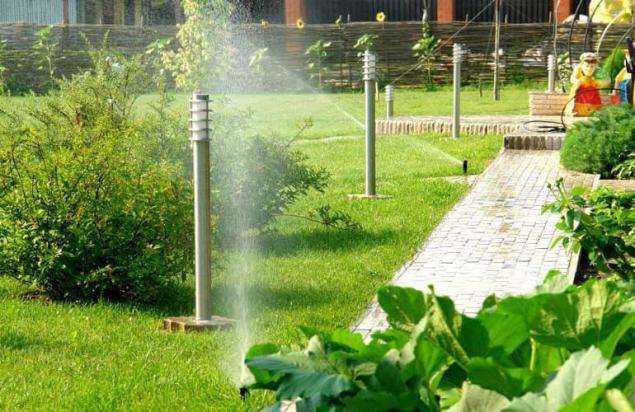
Sprinkler irrigation is the right approach for garden and lawn
Sprinkler irrigation fully simulates weather conditions, therefore, ideal for installation in a private garden. Before starting work you should carefully draw the plan of the entire site with buildings and areas of planting.
Undeniable dignity of choice
The undoubted advantages of the automated irrigation system by sprinkling method include:
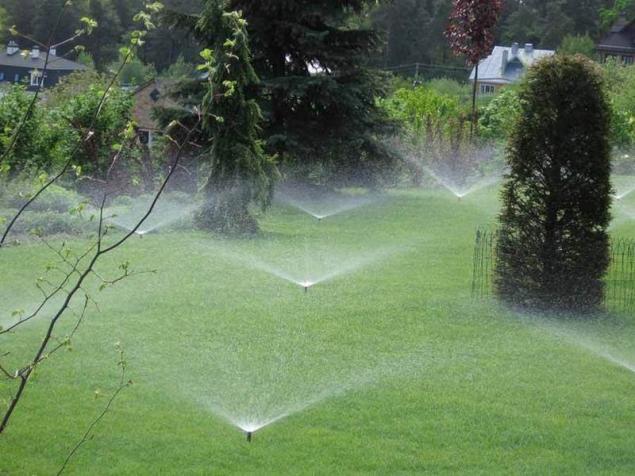
The perfect way for the lawn
Installation of sprinkler irrigation will seriously reduce costs, since the use is directed, accurately timed.

Rotary atomizers
Types and characteristics of spray
When planning the areas that require humidification, it is important to consider full coverage of the entire surface, leaving no empty seats. With this task cope sprinklers having a different radius and flow direction:
1. Rotary – features moving head, providing a large range of irrigation up to 30 m. Also ideal for hard to reach places on the site due to the fact that you can change the angle. For lawns become retractable installation, appearing above ground only when necessary. This option is convenient because it is impossible to damage the item during grass cutting.
2. Radial (pulse) – water is fed in a strictly specified direction, at equal intervals of time and without the possibility of rotation. Maximum conveying distance is 18 m. Such installations are distinguished by a large flow of water.
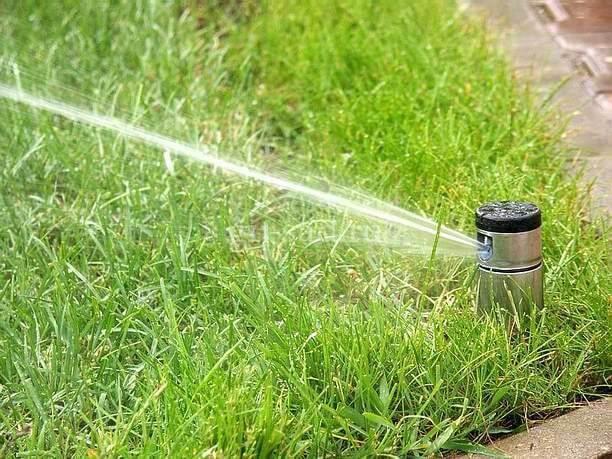
The pulse form of a spray
Order and mounting technology
To make an irrigation system with your own hands, you will need:
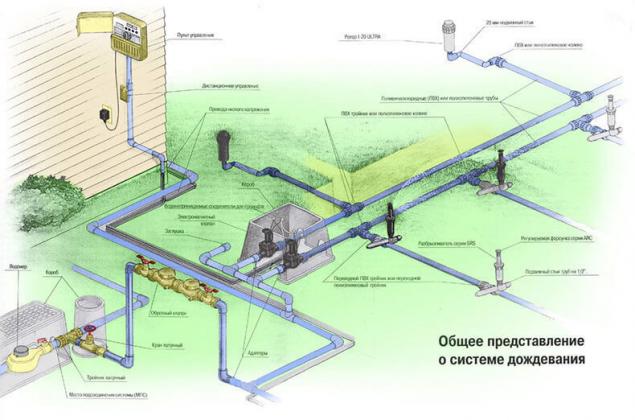
The approximate scheme sprinkler irrigation
Pipe lay in the trench so that the center was the main line, and adjacent to it was a secondary tube of smaller diameter. All connections are firmly fixed fittings. For future savings, be sure to install a soil moisture sensor that is blocking the program during a rain.
Lay the wires to the controller and connect to the source, which is usually a special tank blue. The water in the tank can flow from the tap or wells, but not necessarily through the filter. Before backfilling the trench to produce a trial run of the whole structure with adjustable sprinklers.
For low plantings not always advisable to use nebulizers. You can install drip irrigation on a separate zone. During installation it is necessary to take into account that a single line cannot be different types of nozzles, as this will reduce the pressure in the structure. For each line set your tap.
Drip irrigation is a great choice for garden or greenhouse
If necessary, wetting only the root part of the vegetable crops suitable drip irrigation, which also can be mounted independently. In specialized stores a large selection of ready-made designs from different manufacturers, but not to save, as the work is done for a long period of use.
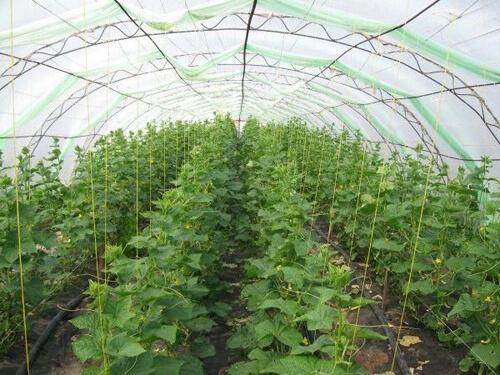
Ideal for greenhouses and garden
The list of advantages
It is no secret that vegetable and garden cultures need a different approach to care. So, the benefits of drip irrigation for growing vegetables and fruits in the garden or greenhouse are:
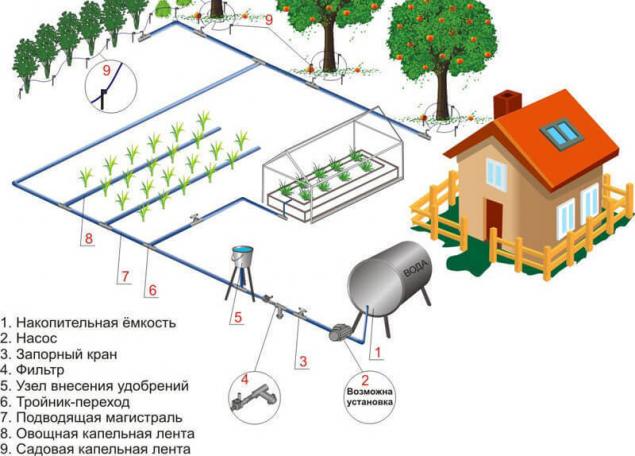
The irrigation scheme in the garden
How to make installation with your own hands
When installing a purchased design is easy to assemble following the enclosed instructions. But you can build a automatic watering system yourself, by purchasing the necessary materials.
To work need:

The scheme of installation in the greenhouse
A significant disadvantage and how to deal with it
When the considered arrangement is only one, but quite a significant disadvantage – uneven wetting of the earth. The fact that the minimum supply of water will allow enough to humidify spaces only at the beginning of the strip lines. The last row of plants will suffer. The pressure increase will lead to waterlogging.
To improve the situation are possible with the optional installation of the dispenser, which will monitor the moisture of the land in each zone. It can be purchased at specialty stores or make your own using plastic bottles.
How to choose a controller type
You can find several types of timers (controllers):
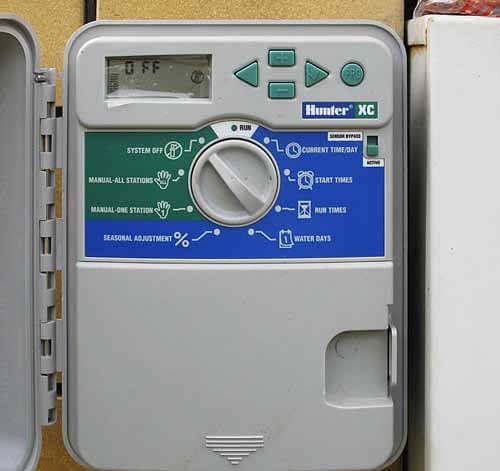
Programmable controller
Despite the fact that it is recommended to plant together plants that need the same moisture of the earth, yet different areas on the lot must conform to its principle of irrigation systems. The timer is easily programmed to the desired time on and off, different cycles and modes.
The most expensive is a fully automated timer, which are set manually initial configuration, and further work is carried out without attention of the gardener. The budget option is a mechanical timer that requires to independently turn on and off the machine.
It is to such timers, connect the rain sensors and moisture, saving the expense and not being able to join the program during rain or high soil moisture.
On the digital device you can connect a function of duration time. There are also multi-channel and single-channel controller depending on how the irrigation system. The first is the ability to install programs for each area of the site. Thus, one machine can be responsible for watering flower beds, lawns, greenhouses and vegetable garden.
The process of construction of highways for automated water supply to the plantations contains a lot of nuances to consider. You cannot ignore the advice of experts if you have the opportunity to contact them. For large areas it is recommended that the invitation professionals – they will help to calculate and design everything to work.published
See also:
Manufacturer of pyrolysis boiler to heat the house
Green roof — a beautiful eco-friendly solution for Your home
P. S. And remember, only by changing their consumption — together we change the world! ©
Join us in Facebook , Vkontakte, Odnoklassniki
Source: 101dizain.com/ustrojstvo/poliv/dozhdevalnaya-i-kapelnaya-sistemy-poliva.html

Sprinkler irrigation is the right approach for garden and lawn
Sprinkler irrigation fully simulates weather conditions, therefore, ideal for installation in a private garden. Before starting work you should carefully draw the plan of the entire site with buildings and areas of planting.
Undeniable dignity of choice
The undoubted advantages of the automated irrigation system by sprinkling method include:
- increasing the humidity of both soil at the roots, but the surface layer, which is important to lower the temperature and avoid loss of moisture by evaporation;
- clearing the area of leaves in a natural way from dust and dirt, which improves the access of oxygen and positively influences the development and yield as a whole;
- a variety of adjustment of pressure;
- the possibility of applying for all horticultural crops;
- the combination of fertilizer;
- the invisibility of the construction in landscape design with proper installation.

The perfect way for the lawn
Installation of sprinkler irrigation will seriously reduce costs, since the use is directed, accurately timed.

Rotary atomizers
Types and characteristics of spray
When planning the areas that require humidification, it is important to consider full coverage of the entire surface, leaving no empty seats. With this task cope sprinklers having a different radius and flow direction:
1. Rotary – features moving head, providing a large range of irrigation up to 30 m. Also ideal for hard to reach places on the site due to the fact that you can change the angle. For lawns become retractable installation, appearing above ground only when necessary. This option is convenient because it is impossible to damage the item during grass cutting.
2. Radial (pulse) – water is fed in a strictly specified direction, at equal intervals of time and without the possibility of rotation. Maximum conveying distance is 18 m. Such installations are distinguished by a large flow of water.

The pulse form of a spray
Order and mounting technology
To make an irrigation system with your own hands, you will need:
- plastic pipe;
- fittings for connection;
- sprinklers;
- pump;
- cranes required diameters;
- programmable controller;
- wire with a protective sleeve;
- other tools for installation.

The approximate scheme sprinkler irrigation
Pipe lay in the trench so that the center was the main line, and adjacent to it was a secondary tube of smaller diameter. All connections are firmly fixed fittings. For future savings, be sure to install a soil moisture sensor that is blocking the program during a rain.
Lay the wires to the controller and connect to the source, which is usually a special tank blue. The water in the tank can flow from the tap or wells, but not necessarily through the filter. Before backfilling the trench to produce a trial run of the whole structure with adjustable sprinklers.
For low plantings not always advisable to use nebulizers. You can install drip irrigation on a separate zone. During installation it is necessary to take into account that a single line cannot be different types of nozzles, as this will reduce the pressure in the structure. For each line set your tap.
Drip irrigation is a great choice for garden or greenhouse
If necessary, wetting only the root part of the vegetable crops suitable drip irrigation, which also can be mounted independently. In specialized stores a large selection of ready-made designs from different manufacturers, but not to save, as the work is done for a long period of use.

Ideal for greenhouses and garden
The list of advantages
It is no secret that vegetable and garden cultures need a different approach to care. So, the benefits of drip irrigation for growing vegetables and fruits in the garden or greenhouse are:
- significant saving of consumption;
- wetting only the soil and roots directly;
- the impossibility of getting water on the leaves, which prevents the formation of sunburn in summer;
- adjustment of the delivery head;
- the possibility of fertilizer;
- there is no need to loosen the top layer of soil.

The irrigation scheme in the garden
How to make installation with your own hands
When installing a purchased design is easy to assemble following the enclosed instructions. But you can build a automatic watering system yourself, by purchasing the necessary materials.
To work need:
- plastic pipe;
- dispensing taps;
- adapter;
- drip tape;
- related materials.

The scheme of installation in the greenhouse
A significant disadvantage and how to deal with it
When the considered arrangement is only one, but quite a significant disadvantage – uneven wetting of the earth. The fact that the minimum supply of water will allow enough to humidify spaces only at the beginning of the strip lines. The last row of plants will suffer. The pressure increase will lead to waterlogging.
To improve the situation are possible with the optional installation of the dispenser, which will monitor the moisture of the land in each zone. It can be purchased at specialty stores or make your own using plastic bottles.
How to choose a controller type
You can find several types of timers (controllers):
- auto;
- mechanical;
- electronic;
- digital.

Programmable controller
Despite the fact that it is recommended to plant together plants that need the same moisture of the earth, yet different areas on the lot must conform to its principle of irrigation systems. The timer is easily programmed to the desired time on and off, different cycles and modes.
The most expensive is a fully automated timer, which are set manually initial configuration, and further work is carried out without attention of the gardener. The budget option is a mechanical timer that requires to independently turn on and off the machine.
It is to such timers, connect the rain sensors and moisture, saving the expense and not being able to join the program during rain or high soil moisture.
On the digital device you can connect a function of duration time. There are also multi-channel and single-channel controller depending on how the irrigation system. The first is the ability to install programs for each area of the site. Thus, one machine can be responsible for watering flower beds, lawns, greenhouses and vegetable garden.
The process of construction of highways for automated water supply to the plantations contains a lot of nuances to consider. You cannot ignore the advice of experts if you have the opportunity to contact them. For large areas it is recommended that the invitation professionals – they will help to calculate and design everything to work.published
See also:
Manufacturer of pyrolysis boiler to heat the house
Green roof — a beautiful eco-friendly solution for Your home
P. S. And remember, only by changing their consumption — together we change the world! ©
Join us in Facebook , Vkontakte, Odnoklassniki
Source: 101dizain.com/ustrojstvo/poliv/dozhdevalnaya-i-kapelnaya-sistemy-poliva.html



